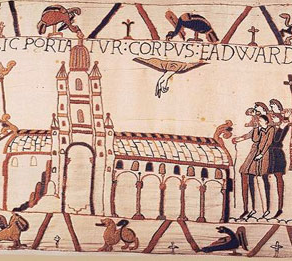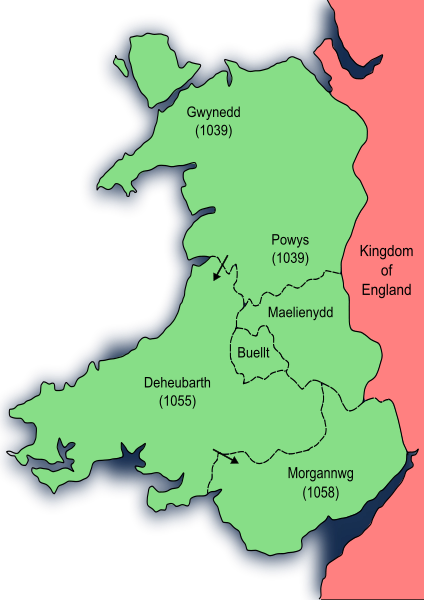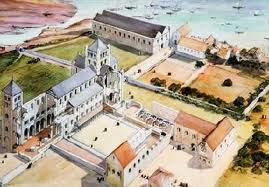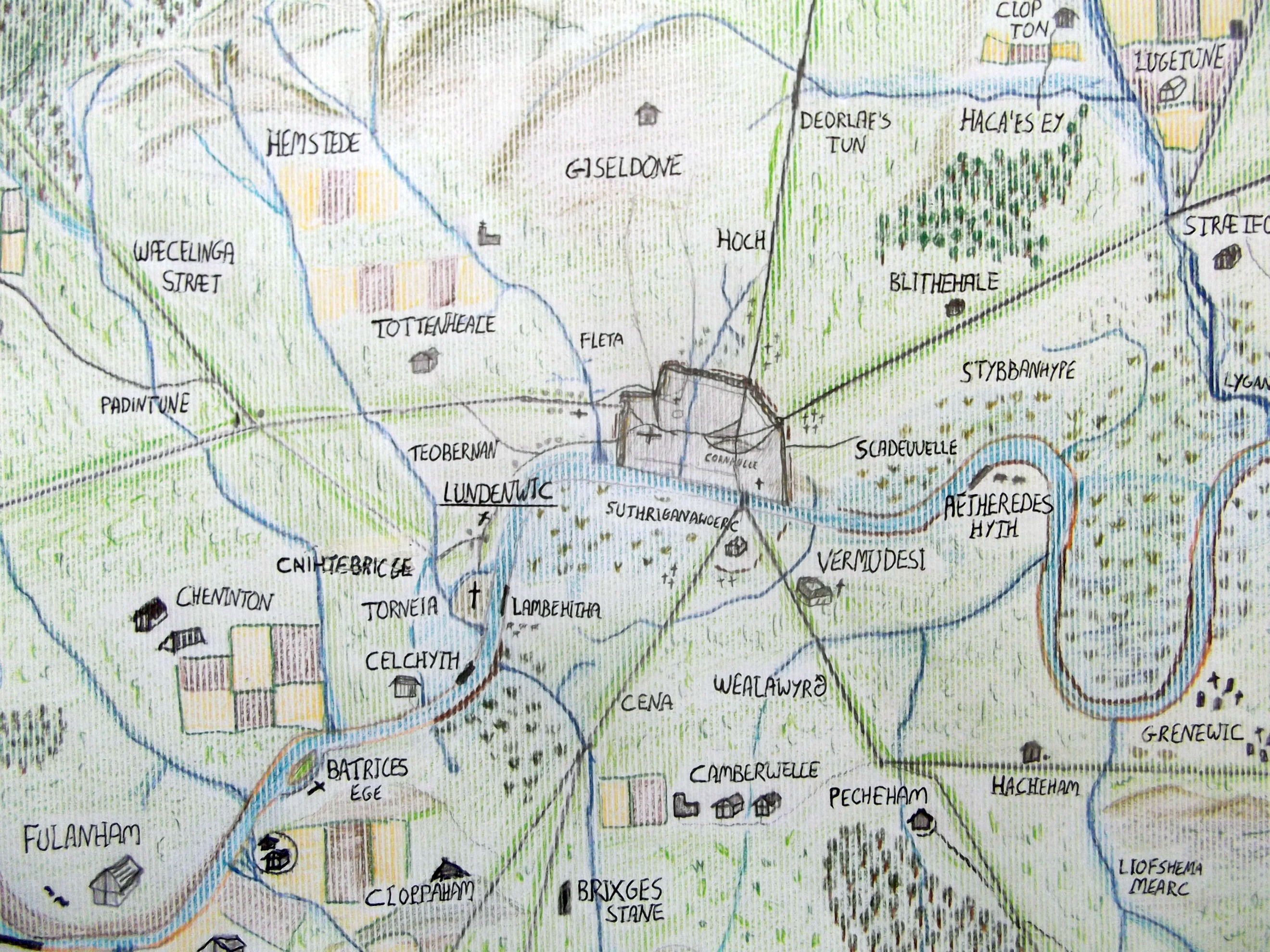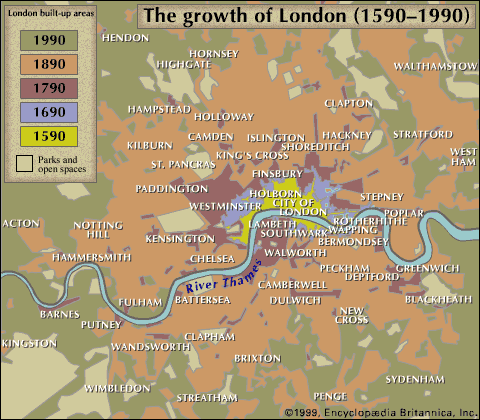Edward enjoyed one year of independence in 1051-2, before the return of Godwin forced him into humiliating submission. But after Godwin’s death the following year, the rest of his reign was broadly peaceful and prosperous, including building Westminster Abbey. Though that’s not to say there’s no political difficulties along the way.
Edward sows the seeds of his own destruction
In 1051, Edward had won because of the support of earls Leofric and Siward. Edward then proceeded to alienate both these men, by employing more French at court, and striking up a friendship with William of Normandy.
Godwin returns – and dies
In 1052 Godwin returned, and in a confrontation in London King Edward is forced into submission. As part of the deal he has to take Godwin back, and get rid of his foreign friends. But within a year Godwin dies – and hands over to his much more affable son, Harold.
The rise of the Godwinssons
Although the Godwin family are not penalised on the death of Godwin, it’s Leofric who gains most as Aelfgar takes over the Earldon of East Anglia as Harold moves to Wessex. But over the next 10 years or so, the Godwinssons are back. The death of Siward and Leofric makes harold the leading man in England. His brother Tostig is made Earl of Northumbria in Siward’s place.
Gruffyd ap Llewellyn and the Welsh wars
Gruffyd ap Llewellyn is the only Welsh leader to unite all the states of Wales. But between 1039 and 1055, that’s what he managed to acheive.
He also used the opportunities thrown up by the mysterious relationship between Aelfgar Leofricsson and Edward the Confessor, which meant that Aelfgar was twice thrown out of his earldom. In 1055 and 1056, Gruffyd and Aelfgar sacked Hereford and forced Edward to cede a significant amount of land on the Welsh border.
In 1058 it all flares up again, but in 1063 Harold and Tostig Godwinsson decide that enough is enough, and mount a concerted campaign. The campaign established Harold’s reputation as an able military comander, able to make his army move with speed in line with a decisve strategy.
London and Westminster Abbey
Meanwhile, Edward the Confessor famously concentrated on building his chruch. He selected an inhospitable eyelot in the Thames called Thorney, and set about building a church on a massive scale. It gave him the chance to indulge his love of French and Norman culture, and well as demonstraing his piety.
London had become the leading town of Anglo Saxon England, with 10-12,000 inhabitants. There’s a couple of maps here – a nice hand drawn map from http://londonist.com/, and one showing the growth of London from 1590 – just so that you can see the scale.
Transcript
We left off last week with Edward the Confessor at his personal high spot. He’d had to eat a lot of humble pie over his last 10 years, but for a year from September 1051, Edward was able to taste the fruit of freedom.
His reaction showed where his heart really lay, and sewed the seeds of his own destruction. Edward had spent most of his life in Normandy, and the English court was alien to him. His leading earls, Siward and Leofric appeared to have little interest in court and national power in the way that Godwin did. So, freed from Godwin’s control, it was Normandy and the Normans that he turned to. French lords were given land and positions at court. The English hated it, and described them as men who ‘promoted injustice, gave unjust judgements and counselled folly’. The truth is probably more that, in the local shire and hundred courts, these new Normans lords were administering a justice system and set of laws that were alien to them – and simply making mistakes.
But worst of all, Edward invited his nephew William of Normandy over to England for a visit. William arrived with a full entourage, and visit of this kind was most unusual for the time; looking back, I don’t think we have seen such a thing so far have we? Unless they came to rape and pillage of course. But to cap it all, Edward went and nominated William as his heir. It seems a slightly odd decision; the obvious choice was Edward the Exile, son of Edmund Ironside, stuck out in Hungary. But I don’t suppose it is quite so bizarre – if things had been different, and Harold had not happened, the transition of power to William would also have been very different, and in all likelihood William’s actions after 1066 very different. But anyway, we’ll come to that, no need to get ahead of ourselves.
But to be honest, Edward had blown it. Because the public mood began to change against him. People began to remember that Godwin had only been banished for standing up to the hated Frenchmen on behalf of an English landlord.
Godwin had not stayed still nursing his wounds for long. He spent 9 months gathering a fleet and army, and then in June he appeared off the south east coast of England at Dungeness, avoiding a fleet stationed by the King off Sandwich. In some ways this was a promotional event, a marketing roadshow; he offered no violence but got assurances of support from the fighting men of Kent, Sussex and Surrey. This was afterall his hood, and the place that had been threatened by Eustace’s violence.
Meanwhile, the men that Edward had raised up to replace Godwin, Odda of Deerhurst and Ralph of Mantes, made something of a has of the defence. The fleet kept getting blown back into shore while Godwn roved up and down the coast. Eventually, they returmed to London, maybe to replenish supplies, and set out again. At this point, Godwin retired to Flanders again; but then to his delighted astonishment he saw the crews of the Kings ships decide they’d have enough and completely abandon the fleet. It all has the feel of Aethelred about it.
Godwin took full advantage and took his fleet to the Isle of Wight, which he raided until its inhabitants submitted, then did the same thing in Portland. Harold meanwhile was coming to meet him after a brief engagement in the West Country.
They then changed tactics, stopped raiding and tried to win over the local population – Godwin knew that he needed a larger force to win back his position. He was fantastically successful, and he was joined by the ships from towns along the coast – Pevensey, Romney, Hythe, Folkestone, Dover, Sandwich. He had enough, and with a fleet considerably larger than the Kings.
The King had sent for help from the north, but Godwin was too fast, and before Edward’s cavalry arrived his force was surrounded by Godwin’s ships, which had sailed right up the Thames and passed through the Bridge.
Now the tables were reversed. Once again, the witan and the armies were unwilling to fight each other, and this time Siwards and Leofric were also unwilling to force the issue also. This is really important – why not? They were effectively letting a rival back at the expense of public humiliation for the King. I think there are probably two reasons; firstly because they all feared a civil war at a time when Svein Estrithson or Harold Hadrada were looking at England with predatory eyes. And Secondly, last time they had seen their support rewarded by an influx of Normans into authority and power.
So this time it was Edward who suffered as a result of the witan’s wish to compromise. Stigand, the Bishop of Winchester, mediated a truce, hostages were exchanged and Godwin came ashore. The witan met outside London, and Godwin swore multiple oaths to repudiate all the charges laid against him the previous year. There’s one other factor worth mentioning about Siward and Leofric; they must have been comfortable with the balance of power if Godwin returned; they clearly felt comfortable that they could make sure that he did not get out of control.
But Edward’s period of freedom was over. The Witan established what it called ‘full friendship’ between Godwin and the King; the kind of friendship the Board of Directors gives a manager after 10 straight defeats. But more than that, Godwin pushed Edward’s nose firmly into the mire. All the Frenchmen who had lately come into England were outlawed; the Archbishop of Canterbury, Robert of Jumieges, who had been appointed over Godwin’s nominee was banished with them and fled for his life back to France. The Queen was brought back to court. Harold and Godwin were restored to their earldoms. Svein Godwinson did not profit from the Godwin come back only because he had died on his return from pilgrimage to atone for his many sins.
The Godwin family was now firmly ensconced in power, and were irremovable; Edward had had just the one chance – and he knew it. It also removed the Norman faction permanently from power, and we can hear the first nail hammering into the English coffin. William of Normandy was left without a party to support his claim in England, and a strong antipathy on the part of all Englishmen to that claim. If he wanted the throne of England, he would have to fight for it.
It’s very difficult to read Edward’s attitude to all of this; the interpretations we can choose I think are
a) Edward’s spirit is broken, he withdraws into his shell, concentrates on Westminster abbey, gives up his attempt to control events and hands over to the Godwins
b) He decides that he simply has to live with Godwin, but remains fully involved in politics; and after Godwin’s death, the sting is gone from his relationship with the Godwin’s anyway.
It’s something we should keep in mind as we go through the rest of Edward’s reign; a), beaten weakling, b) realistic and determined political infighter. . .
It was fortunate for Edward that he did not have to suffer the daily indignity of Godwin’s victory for too long. Just 7 months later, on 10th April 1053, Godwin sat with the king at feast, along with his sons, which no doubt the King was loving. Then Godwin had a seizure, and was dead 5 days later.
We see no revenge visited on the Godwin tribe at this point. But we do see the clear evidence that Siward and Leofric gave balance to the power of the Godwin’s, and that this balance allowed Edward to rule effectively despite his humiliation. Harold was allowed to succeed to the earldom of Wessex, but his own position as earl of East Anglia went to Leofric’s son Aelfgar, not to Harold’s brother Tostig. Ralf, Edward’s Norman nephew, was given a territory of Oxfordshire and Hereford, and made serious attempts to model Herefordshire around a castle and mounted militia – in the fashion that would become the norm under the Marcher lords.
With the departure of Godwin, then, the next 13 years are apparently relatively free of the kind of internal strife and politicking that had characterised his reign so far. I guess you either interpret this as Edward buckling under, or that now that Godwin is gone the boil is lanced. I should come clean I guess; I prefer the latter interpretation, and I think Harold himself may have had something to do with this. He was a very different character to his father, much more affable, and a couple of times we see evidence that he’s more than prepared to meet Edward half way, and may have had a pretty good rapport with him. He seems to accept the reduction in Godwin power from the re-organisation of Earldoms; and later we’ll see him backing his king rather than his brother Tostig.
With Denmark and Norway now seemingly too preoccupied with each other to offer a threat to England, the traditional borders with Wales and Scotland played more of a role.
It was Earl Siward’s of Northumbria’s last campaign that took him northwards into conflict with Scotland. In 1041, a king called Macbeth came to the throne in Scotland by killing the current ruler, Donnchad – and yes, we are talking about that Macbeth, and indeed that Duncan. It’s not clear, but it’s possible that Siward had fought and deposed MacBeth earlier in the reign, in 1046, but if that was so, Macbeth had regained his kingdom soon after. But in 1054, Siward mounted another expedition, which culminated in the battle of the seven sleepers. The reasons are obscure, but it seems possible that Siward was acting to help put another king on the throne – namely Malcolm, son of the Duncan murdered by MacBeth. Siward won the battle, and put MacBeth to flight – but despite gaining plenty of plunder, he paid a heavy price with the death of his son, Osbert. It also seems that McBeth survived the war, and it was not until a few years later that Malcolm was able to depose Macbeth permanently.
England paid a greater price for the battle of the seven sleepers. Because when Siward died a year later in 1055, his remaining son Waltheof was too young to take over his earldom. So instead, Edward made Tostig Godwinsson, Harold’s brother, earl of Northumbria. Tostig had his successes; he established a good relationship with Malcolm when he did become King of Scots, even to the point of arranging a royal visit to Edward in 1059, the first visit by a Scottish king since Kenneth had rowed Edgar up the River Dee. But he was not a success in ruling Northumbria. He didn’t have the long connection that Siward’s family had, and his connections were all southern English. Tostig was to lose his earldom 10 years later, in circumstances that made him an enemy of his brother and of England, with dire consequences in 1066.
Edward and the Witan’s thoughts had meanwhile turned to the succession, and in 1054 Edward the exile was invited back to court. You may remember that Edward was the son of Edmund Ironside, who had been sent to be killed by Cnut – but had managed to end up in Hungary, where he married a Princess and seemed set to live happily ever after. His recall to England did not seem to fill him with massive enthusiasm, since it takes him 2 years to arrive at Edward’s court. And he died 2 days later. Was it murder? The chroniclers do not seem to suggest so, though there is the strange line that laments that he was stopped from seeing the King – but we know no more that that. Edward the Exile’s death was the end of the last chance for an undisputed succession. Although he did have children including Edgare the Atheling, they were way too young to assume the throne when Edward the Confessor died. So as you can see, the various pieces of the 1066 jigsaw are slowly coming together… Edward the Exile’s children do have a part to play on the political stage – though not Edgar the Atheling who seemed happy enough to go along with William the Conqueror’s accession. Edward the Exile’s othere children were Saint Margaret of Scotland, whose daughter, Edith, was to marry Henry I, the king who began to heal the wounds between English and Norman in the next century. But I’m getting ahead of myself.
England was also forced to fight against another traditional enemy, the Welsh, in the form of Gruffyd ap Llewellyn. Gruffyd was born around 1007, and was to be the only welsh rule who managed to rule over all the welsh Kingdoms. Wales at the time was split into 5 Kingdoms – there’s a handy map on the website, by the way. Gruffydd had to work for all his success. By 1039, he had made himself king of Powys, and then in 1039 to managed to add Gwynedd to his portfolio when king Iago was killed by his own men. England then got its first taste of trouble, when he attacked Mercia and defeated and killed Leofric’s brother Edwin. Between 1039 and 1055 Gruffydd concentrated on bringing the largest kingdom of the south wales, Deheubarth, under his control. He successfully captured the Kingdom from Hywel in 1041, despite Hywel returning with the help of the Vikings. In 1047, Gruffydd of Gwent in turn pushed ap Llewelyyn out, and it was not until 1055 that Gruffyd ap Llewellyn finally finished the job and took control.
In the interim he kept the English interested, with a raid into Herefordshire in 1052 for example. With most, though not all of Wales under his control, in 1055 he was ready for another go.
Meanwhile events in England were to give him a helping hand. You might remember a man called Aelfgar, earl of East Anglia. Aelfgar had been made the earl of East Anglia, when Harold moved from the post to take his Dad’s job in Wessex; Aelfgar was also the son of Leofric, the earl of Mercia. He is also probably, by the way, the son of Lady Godiva, who was married to Leofric. Coming from Leicestershire as I do, the story of Lady Godiva riding through nearby Coventry clothed only in her long hair was one I learnt at my mother’s knee. So it was a hoot to discover that she’s a real historical figure. The story goes that Godiva begged Leofric to lift his oppressive taxes, and Leofric retorted that he would do so only if she rode naked through the streets. So Godiva told everyone to stay indoors and not look, and did just that – and so Leofric had to reduce his taxes. I also found out that the phrase peeping Tom comes from the same legend – Tom, apparently was a man who did look, and was struck blind as a result.
But look, this isn’t history! Sorry about that, back to the main event.
So anyway, in the spring of 1055, we are told that Aeflgar was outlawed by the Witan for treason. There’s really no explanation as to why this is; the event is mentioned by 3 Chroniclers, one of whom said he was innocent another that he was pretty much innocent, and the third that he admitted his own guilt. But whatever did happen this is a seismic event, for one of the country’s most powerful families.
We get no reaction from his father, but Aelfgar is unrepentant. He went straight to Ireland and raised a force of 18 ships packed full of Vikings, and then teamed up with Gruffydd. They aimed straight for Mercia, by the easiest route through Hereford, where Edward’s man, Ralph, had been trying to build a castle and mounted militia on the Normand model. The English were unused to these novel methods, and they fled before the onslaught and Hereford was ransacked.
The England’s army and militia was called out and given to Harold to command. The invaders had to fall back into the Black Mountains, and a stalemate ensued. Harold, Aelfgar and Gruffydd came to terms, and rather remarkably Leofric was reinstated as the earl of East Anglia, while Gruffydd was probably recognised as the rule of some disputed land on the English Welsh border.
The next year the conflict was renewed, this time when the Bishop of Hereford Leofgar, in the best traditions of muscular Christianity took matters into his own hands and raided into Wales. He was sadly no match for Gruffydd, and was killed along with his Shire Reeve, compelling the English again to march against him, with Harold and Leofric at its head. This time the ensuing treaty agreed that Gruffydd would swear to be a faithful under king to Edward, and in return he was conceded a considerable amount of land, land that had probably been in English hands since the 8th Century.
This kept the peace for over a year; during which Leofric died, and Aelfgar took over the Earldom of Mercia. This prompted a re-organisation, in which the Godwin family was a winner; the fourth Godwinson, Gyrth was given the job of earl of east Anglia, and Leofwine, the even younger Godwinsson, was given an earldom to boot, a new territory carved out in the South East of England. Ralph’s earldom of Hereford was subsumed into Harold’s Wessex. Given that all the earls of England except Aelfgar were Godwinsson’s now, Aelfgar must have felt rather out gunned. And what’s going on here with Edward – is this a sign of strength, and confidence in the Godwinssons; or were these changes forced on Edward? Although I still subscribe to the view that Edward, the light of his even-handed re-distribution of power in 1053, was a willing participant, but you have to think that all this power in the hands of one family was not a great idea.
Maybe the rising power of the house of Godwinsson worried Aelfgar, for it pushed him closer to Gruffydd. In 1057 he married his daughter, Ealdgyth to Gruffydd. And then in 1058 he is in revolt again.
This time the Chroniclers excel themselves with their brevity. So speaks the ASC:
‘Earl Aelfgar was driven out, but he soon came back with Gruffydd’s help. A ship force came from Norway – it is tedious to tell how it all happened’.
I am bound to question the commitment of this chronicler – afteral it’s not the most onerous job in the world, with just a few lines to write each year, and I think he might have bothered to give us a bit more information. Irish chroniclers do rather better, in that they record a major descent on England by the son of Harold Hadrada from Norway, in association with Gruffydd. But all we know is that Aelfgar is again restored as a result. You have got to say that this looks a little weak on Edward’s part. Is the guy in or is he out?
Aelfgar lasted just 4 years after his second restoration, and clearly remained an ally of Gruffydd throughout. He was succeeded in his earldom by his young son Edwin, who would have been too inexperienced to fight the power of the Godwinssons. It meant that Harold had the chance he had been looking for to fight back against Gruffydd. IN 1063 he and his brother Tostig made a concerted attack on Gruffydd, in a style that earned Harold his reputation as a bold and successful warrior. Harold struck across Wales from South to North, from Gloucester to Rhuddlan, to Gruffydd’s main centre. He failed to capture Gruffydd, but burned his ships and hall and drove him to flight. Harold then went by ship to south wales, while Tostig and his cavalry invaded from Northumbria into North wales. The two met and joined their armies and Gwynedd itself was conquered. In August the end came for Gruffydd, as his own men killed him in August, and Harold was able to send Gruffydd’s head and the figure head of his ship back to Edward in triumph.
Wales went back to it’s constituent kingdoms and dynasties, and nothing was left of Gruffydd except a tradition of a united Wales.
Harold must have been supreme – popular from his victory, and the head of the most powerful family in England. He must have realised that the Crown was within his grasp; the obvious heir, Edgar the Atheling, son of Edward the Exile, was far too young to inherit. In 1064, everything must have seemed possible.
And what of Edward during all this time? He seems curiously absent, though there is no indication in charters that he is anything other than a fully engaged ruler. The tradition, though is of a pious king who became slightly withdrawn, relied on Harold to do the muscular stuff while he concentrated on his pet project, the building of the Abbey of Westminster.
In the spirit of never under complicating things, I think I’ll start on this story by talking about London, on the tenuous ground that the site selected for Westminster Abbey was in itself interesting.
The Roman town of Londinium had been Roman Britain’s most successful trading town, and surrounded by impressive walls. When the Saxons arrived they distrusted the Roman city, and instead established their town further to the West, in the area around the River Fleet, which probably formed their harbour; this is the area now called the West End, and was then called Lundenwic. The deserted Roman town remained, however, called LondonBurgh. When the Vikings came raiding, the Saxons abandoned their distrust and sought the safety of the Roman Towns walls. I have put a couple of maps onto the website; it was difficult to find the perfect thing, but there was a really good hand drawn map that pretty much does the job, and I am sure you can have fun deciphering the Old English names; and there’s a map showing development from 1590 that also helps visualise the scale of it all.
Edward decided that England must have a Cathedral that reflected its power and richness. He had been brought up in Normandy, so his image was for a cathedral in the great Norman style like Jumieges, but intended to be greater than all of them. He selected an area called the Island of Thorney, which was an eyot in the River Thames surrounded by marshland. Nowadays, of course, there is no sign left that it was ever an island. The new Abbey replaced a small and insignificant church dedicated to St Peter and monastery founded by St Dunstan.
There are a couple of points to make about Westminster Abbey. Firstly, its scale and ambition illustrates how far the English state had come since the terrible wars at the start of the century – it was enjoying a period of peace, stability and prosperity. Secondly, it is a bit ironic that the penultimate West Saxon King should be building an Abbey in the style of the Normans, who are so soon to replace his dynasty. And finally, his decision to build in London reflected a new reality that this was where the capital should be. Winchester had been the traditional capital, reflecting the history of Wessex’s take over of the rest of England. But London was clearly the most successful trading centre in the country. The fact that it had been a central point in all the struggles with the Vikings, and between the king and Godwin, reflects its importance. With the building of Westminster abbey, designed to hold the body of the King, this became undisputed fact.
Edward died just a few days after the Abbey’s consecration. He remains a difficult figure to understand, as we mentioned earlier. I would stick to my view that although the tradition is of a pious, mild and likeable man, I don’t believe he was a weak pushover. He came in blind into a difficult political situation, and was clever and subtle enough to bide his time – but strike against Godwin he certainly did. I think that once Godwin was gone, he was happy enough to work with Harold, and happy enough to see him as a partner in government. How ever you look at it, this is not a situation someone like William the Conqueror would ever live with, but I think Edward the Confessor should be given some credit for the peace and stability he helped to create. In the 12th Century he was canonised, and until 1348 was the patron saint of England, and is still regarded by the RC church as the patron saint of monarchs, difficult marriages and separated people.

